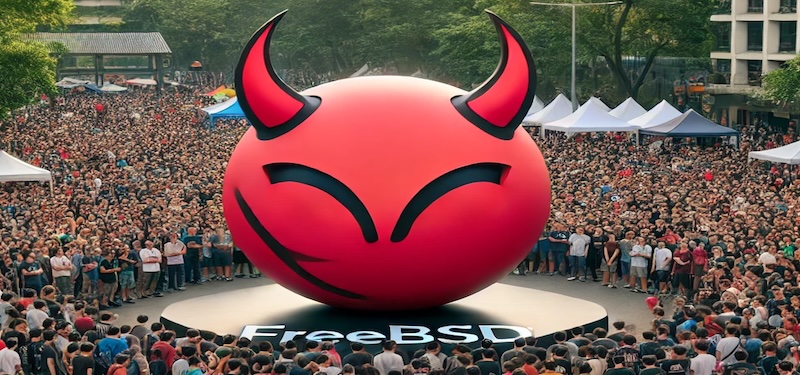FreeBSD: How Can We Make It More Attractive to New Users?

For nearly 15 years, FreeBSD has been at the core of my personal infrastructure, and my passion for it has only grown over time. As a die-hard fan, I’ve stuck with BSD-based systems because they continue to deliver exactly what I need—storage, networking, and security—without missing a beat. The features I initially fell in love with, like ZFS, jails, and pf, are still rock-solid and irreplaceable. There’s no need to overhaul them, and in many ways, that reliability is what keeps me hooked. My scripts from 20 years ago still work, and that’s a rare kind of stability that few platforms can boast.
It’s not just me, either—big names like Netflix, Microsoft, and NetApp, alongside companies like Tailscale and AMD, continue to support FreeBSD, further reinforcing my belief in its strength and longevity (you can find the donators and sponsors right here). Yet, while this familiarity is comforting, it’s becoming clear that FreeBSD must evolve to keep pace with the modern landscape of computing.
In the early days, FreeBSD’s offerings felt revolutionary. Its core features and tools were a breath of fresh air compared to alternatives. But the tech world has changed, and in many ways, FreeBSD needs to catch up. We can’t just cling to what works and ignore the demand for modern features. The challenge isn’t just maintaining a functional and minimalistic system—it’s about embracing newer technologies without losing the simplicity and stability that make FreeBSD special.
Take virtualization, for example. Years ago, Xen, Proxmox, and VMware were the leading solutions, and FreeBSD had its answer in bhyve. But here we are in 2024, and while bhyve works, there’s still no stable support for live migrations of VMs – a feature that enterprises consider crucial. In the world of IT, nobody wants to schedule maintenance windows to patch systems and reboot hosts. It’s inefficient and outdated. Some are working hard to improve this, but for now, it’s more of a proof of concept than a production-ready solution but it is needed and fully appreciated! At this points also thanks to the developers (Oleg Ginzburg, Oleg Minin and also Elena Mihailescu and Mihai Carabaș) behind cbsd and CloneOS (you can find a blog post about ClonOS from me here). You can find the interesting papers about it here. But would I use it in production right now? I guess not and many others wouldn’t either.
Virtualization itself is starting to feel like yesterday’s news. The trend is clearly shifting toward containerization, whether in on-prem solutions or via hyperscalers. FreeBSD, however, is still playing catch-up here too. Podman now supports running Linux containers on FreeBSD 14, but it’s still experimental. Sure, people argue that FreeBSD’s jails are better than other container solutions, and that may well be true. But it doesn’t help users who need to deal with prebuilt images from their colleagues or other companies. Compatibility and ease of use matter, and jails aren’t always the answer when everyone else is using something else.
This brings me to the heart of the issue. FreeBSD needs to adapt faster and more comprehensively to modern demands if we want to make it attractive to a wider audience. Sure, it’s simple, and that’s a big part of why I love it. But the attitude of “it works for me” isn’t enough anymore. I don’t represent the whole user base, and neither do the people who say everything’s fine as it is. We need to appeal to newcomers, and that means making FreeBSD more accessible and user-friendly, not a system that requires workarounds for basic, modern use cases.
One of the ongoing challenges for FreeBSD has been its support for devices like Bluetooth, WiFi, and other hardware components on notebooks and desktop systems. While FreeBSD excels in server environments and embedded systems, the user experience on laptops can be frustrating due to the lack of out-of-the-box support for some critical hardware features. Most users want their machines to simply work without needing to tinker with drivers or configurations. Whether it’s connecting to WiFi, using Bluetooth peripherals, or suspending and resuming from sleep mode, these basic features are essential for a smooth, modern computing experience.
Thankfully, change is on the horizon. The FreeBSD Foundation has made a strategic move to address these shortcomings. This shift is crucial for keeping FreeBSD competitive in today’s landscape, where laptops and mobile workstations dominate how people interact with technology. Users expect seamless functionality without having to configure every aspect of their machine, and FreeBSD must step up to meet this expectation.
Currently, FreeBSD lags behind in key areas such as WiFi and Bluetooth support, as well as laptop-specific functionalities like suspend/resume, digital microphone integration, and hardware buttons for volume and audio controls. These missing features make it hard for many to adopt FreeBSD as their daily driver, particularly for professionals or casual users who rely heavily on their laptops. Closing these gaps is vital if FreeBSD is to broaden its appeal and remain relevant in both personal and enterprise computing. As the FreeBSD Foundation continues to push forward, improving laptop support will not only make FreeBSD more accessible but will also help it thrive in a world that increasingly depends on portable devices.
The system should work out of the box, with support for current technologies. It shouldn’t feel like driving an old, rusty car when what users want is the efficiency of a modern electric vehicle. We can preserve the core simplicity and minimalism of FreeBSD while still updating it to compete with today’s tech landscape. This philosophy is something I’ve tried to bring to life with my BoxyBSD project. The goal is to help newcomers feel comfortable with BSD-based systems, but even that hasn’t been easy. Offering free VPS instances has its challenges, and it’s not just about the technical backend—it’s about making the interface and overall experience inviting too.
I’ve always believed in minimalism, in the KISS (Keep It Simple, Stupid) principle. But as I’ve promoted my BoxyBSD project at conferences, I’ve encountered a recurring issue: people often ask if the website is broken or if images and CSS files are missing. They’re not! It’s just a super minimal design. Yet this response highlights a shift in expectations. Many IT professionals today don’t engage with the foundational knowledge we once relied on – like reading man pages, mailing lists, and newsgroups. They’re looking to forums, Reddit, and Discord channels instead.
This shift in how people learn and interact with technology presents a challenge, but also an opportunity. We have a responsibility to teach, to guide, and to show that BSD, especially FreeBSD, isn’t outdated. It’s more than capable of modern workloads, and we should demonstrate that by adopting new tools and methods. Just because we’ve relied on certain systems for years doesn’t mean we should resist all change. With the BSD Cafe which is operated by Stefano Marinelli, we already have a great place for all kind of BSD enthusiasts in place, also providing an own Fediverse instance and also Matrix Chat as a replacement for Discord but it about us to make people on proprietary platforms aware of this. With the started BSD Pub weekly meetings by Stefano and gyptazy (me), we also encourage new users to get in touch with the community and to learn in live workshops.
That’s why I’m evolving too – changing the design of my blog engine (away from manpageblog, even it’s really cool), moving to more modern solutions, and proving that FreeBSD can stay relevant in a modern way. FreeBSD is not some relic of the past. It’s a robust, adaptable system that, with the right direction, can thrive in the future. Let’s do it together!

[…] ↫ gyptazy […]
Comments are closed.